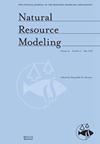利用证据信念函数模型确定土地沉降潜力:伊朗巴达斯坎含水层案例研究
IF 2.1
4区 环境科学与生态学
Q3 ENVIRONMENTAL SCIENCES
引用次数: 0
摘要
在这项研究中,我们采用了证据信念函数模型(EBF)来评估巴达斯坎初级含水层的土地沉降潜力。通过实地考察,我们记录了 174 个地面沉降点的 GPS 坐标。在评估土地沉降潜力时考虑的因素包括水井密度、地下水开采率、地质特征、与断层的距离、植被覆盖率、与河流的距离、坡度和土地使用情况。为开发和验证模型,随机抽取了 70% 的记录点进行训练和实施,其余 30% 则用于模型验证。通过将训练点与河流距离、断层距离、土地利用和开采量等影响变量图整合,确定了相应图层中不同等级的土地沉降点数量和百分比。计算不同层级的 EBF 模型率。最后,利用 GIS 确定了基于 EBF 模型的土地沉降潜力图。结果表明,大部分沉降点位于全新世时期的冲积沉积物中、地下水开采量大的地区、距离河流至少 3000 米的地区、距离断层至少 6000 米的地区、低密度牧场、坡度至少为 0%-2%的地区以及农田和花园。对 EBF 模型进行的接收器工作特性曲线分析表明,利用 30% 的验证数据,该模型可在 87.5% 的情况下准确预测土地沉降。这表明该模型可用于实际应用。本文章由计算机程序翻译,如有差异,请以英文原文为准。
Determining land subsidence potential using the evidential belief function model: A case study for the Bardaskan Aquifer, Iran
In this study, we employed the evidential belief function model (EBF) to evaluate the potential for land subsidence in the primary aquifer of Bardaskan. Through field visits, we recorded GPS coordinates for 174 land subsidence points. Factors considered in assessing land subsidence potential included well density, groundwater extraction rate, geological characteristics, proximity to faults, vegetation cover, distance from the river, slope, and land use. To develop and validate the model, 70% of the recorded points were randomly selected for training and implementation, while the remaining 30% were reserved for model validation. The number and percentage of land subsidence points in the different classes of the corresponding layers were determined by integrating the training points with influential variables maps such as distance from the river, distance from the fault, land use, and extraction volume. The EBF model rate was calculated for different layer classes. For modeling, all rates of the EBF model in each cell were summated, and the potential of land subsidence was calculated. Finally, the map of land subsidence potential based on the EBF model was determined with GIS. The results showed that most of the subsidence points were located in alluvial sediment of the Holocene period, in areas with high groundwater harvesting, a distance of at least 3000 m from a river, a distance of at least 6000 m from a fault, low‐density rangelands, slopes of at least 0%–2%, and farmlands and gardens. A receiver operating characteristic curve analysis of the EBF model showed that it could accurately predict land subsidence in 87.5% of cases using 30% of the validation data. This suggests that the model can be used for practical applications.
求助全文
通过发布文献求助,成功后即可免费获取论文全文。
去求助
来源期刊

Natural Resource Modeling
环境科学-环境科学
CiteScore
3.50
自引率
6.20%
发文量
28
审稿时长
>36 weeks
期刊介绍:
Natural Resource Modeling is an international journal devoted to mathematical modeling of natural resource systems. It reflects the conceptual and methodological core that is common to model building throughout disciplines including such fields as forestry, fisheries, economics and ecology. This core draws upon the analytical and methodological apparatus of mathematics, statistics, and scientific computing.
 求助内容:
求助内容: 应助结果提醒方式:
应助结果提醒方式:


